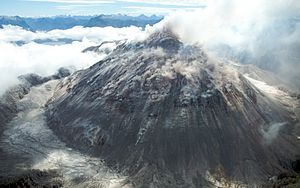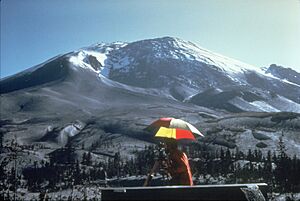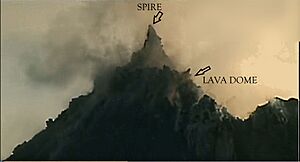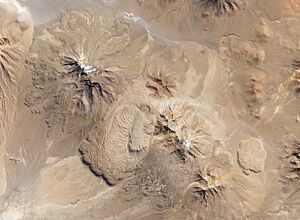Lava dome facts for kids
A lava dome is a round, hill-shaped lump of rock. It forms when thick, sticky lava slowly oozes out of a volcano. These domes are quite common, especially where Earth's plates crash together. About 6 out of every 100 volcanic eruptions create lava domes.
The type of rock in lava domes can be different. Some are made of basalt, like Semeru in 1946. Others are made of rhyolite, like Chaitén in 2010. Most lava domes are made of a mix, like dacite or andesite, seen at Santiaguito today. The dome shape forms because the lava is very thick. This thickness stops the lava from flowing far away. Lava becomes thick either by having lots of silica (a mineral) or by losing its gases. Domes made of basalt or andesite break down quickly. So, most old domes we see are made of high-silica rocks like rhyolite or dacite.
Scientists think there might be lava domes on the Moon, Venus, and Mars. For example, some dome-shaped areas on Mars in Arcadia Planitia and Terra Sirenum could be old lava domes.
Contents
How Lava Domes Grow and Change
Lava domes can be unpredictable. This is because the super thick lava inside them changes as it cools and releases gases. Domes can grow bigger, collapse, harden, and wear away over time.
Lava domes grow in two main ways. One way is `endogenic` growth. This means new magma pushes up from inside the dome, making it swell. The other way is `exogenic` growth. This happens when new blobs of lava pile up on the outside surface of the dome. Because the lava is so thick, it doesn't flow far from the volcano's opening. Instead, it builds up into a dome shape and cools slowly.
Sometimes, sharp rock spikes called `lava spines` can stick out from the dome. Lava flows can also come from domes. Domes can grow to be hundreds of meters tall. They can grow slowly for months, years, or even centuries. The sides of these domes are often made of loose, unstable rocks.
Dangers from Lava Domes
Lava domes can be very dangerous. Gas pressure can build up inside them. This can cause sudden, powerful explosions. If part of a dome collapses, it can expose hot, pressurized magma. This can create fast-moving clouds of hot gas and ash called `pyroclastic flows`. These flows are extremely deadly.
Other dangers from lava domes include lava flows that destroy property. They can also cause forest fires. `Lahars` (mudflows) can also happen. These are triggered when loose ash and debris mix with water. Many large volcanoes around the world, called `stratovolcanoes`, have lava domes. Domes with rhyolite lava, which is rich in silica, are known for especially dangerous explosions.
Before a lava dome explodes, scientists might detect certain signs. These include shallow earthquakes that last a long time. These quakes happen because of pressure from fluids inside the volcano. Scientists also look for the dome's round shape and its growth cycles. However, the speed of dome growth doesn't always tell us when an explosion will happen. If a lava dome collapses due to gravity, it can create a `block and ash flow`. This is a type of pyroclastic flow.
Other Landforms Like Lava Domes
Hidden Domes: Cryptodomes
A cryptodome means "hidden dome." It's a dome-shaped structure that forms when thick magma builds up close to the surface, but doesn't break through. Two famous examples are before the 1956 eruption of Bezymianny and the 1980 eruption of Mount St. Helens. In both cases, the cryptodome pushed the side of the volcano outwards. This caused a huge part of the volcano to collapse. This collapse then led to a massive explosion as the hidden magma was suddenly exposed.
Lava Spines and Spires
A `lava spine` or `lava spire` is a tall, pointed growth. It can form on top of a lava dome. These spines can make the dome even more unstable. A good example is the spine that formed in 1997 at the Soufrière Hills Volcano in Montserrat.
Flowing Domes: Lava Coulées
`Coulées` (pronounced koo-LAY) are like lava domes that have also flowed a bit. They look like a mix between a lava dome and a lava flow.
The biggest known dacite flow in the world is the Chao dacite dome complex. It's a huge coulée flow-dome located between two volcanoes in northern Chile. This flow is over 14 kilometers (about 8.7 miles) long. It has clear signs of flowing, like pressure ridges. Its front edge is 400 meters (about 1,300 feet) tall. Another big coulée flow is on the side of the Llullaillaco volcano in Argentina. Other examples can be found in the Andes mountains.
Famous Lava Domes Around the World
| Name of lava dome | Country | Volcanic area | Main Rock Type | Last Eruption or Growth |
|---|---|---|---|---|
| Chaitén lava dome | Chile | Southern Volcanic Zone | Rhyolite | 2009 |
| Ciomadul lava domes | Romania | Carpathians | Dacite | Pleistocene (very old) |
| Cordón Caulle lava domes | Chile | Southern Volcanic Zone | Rhyodacite to Rhyolite | Holocene (recent geological time) |
| Galeras lava dome | Colombia | Northern Volcanic Zone | Unknown | 2010 |
| Katla lava dome | Iceland | Iceland hotspot | Rhyolite | 1999 onwards |
| Lassen Peak | United States | Cascade Volcanic Arc | Dacite | 1917 |
| Black Butte (Siskiyou County, California) | United States | Cascade Volcanic Arc | Dacite | 9500 years ago |
| Bridge River Vent lava dome | Canada | Cascade Volcanic Arc | Dacite | Around 300 BC |
| La Soufrière lava dome | Saint Vincent and the Grenadines | Lesser Antilles Volcanic Arc | 2021 | |
| Mount Merapi lava dome | Indonesia | Sunda Arc | Unknown | 2010 |
| Nea Kameni | Greece | South Aegean Volcanic Arc | Dacite | 1950 |
| Novarupta lava dome | United States | Aleutian Arc | Rhyolite | 1912 |
| Nevados de Chillán lava domes | Chile | Southern Volcanic Zone | Dacite | 1986 |
| Puy de Dôme | France | Chaîne des Puys | Trachyte | Around 5760 BC |
| Santa María lava dome | Guatemala | Central America Volcanic Arc | Dacite | 2009 |
| Sollipulli lava dome | Chile | Southern Volcanic Zone | Andesite to Dacite | 1240 ± 50 years ago |
| Soufrière Hills lava dome | Montserrat | Lesser Antilles | Andesite | 2009 |
| Mount St. Helens lava domes | United States | Cascade Volcanic Arc | Dacite | 2008 |
| Torfajökull lava dome | Iceland | Iceland hotspot | Rhyolite | 1477 |
| Tata Sabaya lava domes | Bolivia | Andes | Unknown | ~ Holocene (recent geological time) |
| Tate-iwa | Japan | Japan Arc | Dacite | Miocene (very old) |
| Tatun lava domes | Taiwan | Andesite | 648 | |
| Valles lava domes | United States | Jemez Mountains | Rhyolite | 50,000-60,000 years ago |
| Wizard Island lava dome | United States | Cascade Volcanic Arc | Rhyodacite | 2850 BC |
See also
 In Spanish: Domo de lava para niños
In Spanish: Domo de lava para niños








